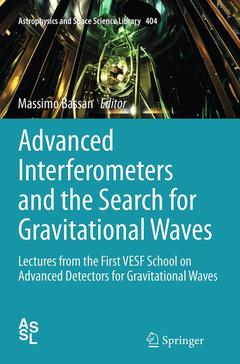Description
Advanced Interferometers and the Search for Gravitational Waves, 2014
Lectures from the First VESF School on Advanced Detectors for Gravitational Waves
Astrophysics and Space Science Library Series, Vol. 404
Coordinator: Bassan Massimo
Language: English
Subject for Advanced Interferometers and the Search for...:
Advanced Interferometers and the Search for Gravitational Waves
Publication date: 09-2016
Support: Print on demand
Publication date: 09-2016
Support: Print on demand
Advanced Interferometers and the Search for Gravitational Waves
Publication date: 03-2014
387 p. · 15.5x23.5 cm · Hardback
Publication date: 03-2014
387 p. · 15.5x23.5 cm · Hardback
Description
/li>Contents
/li>Biography
/li>Comment
/li>
The search for gravitational radiation with optical interferometers is gaining momentum worldwide. Beside the VIRGO and GEO gravitational wave observatories in Europe and the two LIGOs in the United States, which have operated successfully during the past decade, further observatories are being completed (KAGRA in Japan) or planned (ILIGO in India). The sensitivity of the current observatories, although spectacular, has not allowed direct discovery of gravitational waves. The advanced detectors (Advanced LIGO and Advanced Virgo) at present in the development phase will improve sensitivity by a factor of 10, probing the universe up to 200 Mpc for signal from inspiraling binary compact stars. This book covers all experimental aspects of the search for gravitational radiation with optical interferometers. Every facet of the technological development underlying the evolution of advanced interferometers is thoroughly described, from configuration to optics and coatings and from thermal compensation to suspensions and controls. All key ingredients of an advanced detector are covered, including the solutions implemented in first-generation detectors, their limitations, and how to overcome them. Each issue is addressed with special reference to the solution adopted for Advanced VIRGO but constant attention is also paid to other strategies, in particular those chosen for Advanced LIGO.
Preface.- Foreword.- Towards gravitational wave astronomy.- The science case for advanced gravitational wave Detectors.- Interferometer configurations.- Pre Stabilized Lasers for Advanced detectors.- Input Optics System.- Readout, sensing and control.- An introduction to the Virgo Suspension System.- Thermal noise in laser interferometer gravitational wave detectors.- Thermal effects and other wave-front aberrations in recycling cavities.- Stray Light Issues.- A Basic Introduction to Quantum Noise and Quantum-Non-Demolition Techniques.- The Parametric Instability in advanced gravitational-wave interferometers.- A Third Generation Gravitational Wave Observatory: the Einstein Telescope.- Low Temperature and Gravitation Wave detectors.
Massimo Bassan is Associate Professor of Physics at University of Rome Tor Vergata. His research focuses mainly on gravitational waves: he built the first Italian prototype of the interferometer, took part in the development of resonant cryogenic antennas, and he is currently involved in the spatial mission LISA (Laser Interferometer Space Antenna) of ESA. He is also member of the Executive Board of the Virgo-EGO Scientific Forum (VESF) and coordinates the VESF schools on gravitational waves.
Coverage of all experimental aspects of the search for gravitational radiation with optical interferometers Description of the technological developments underlying the evolution of advanced interferometers Special focus on the solutions adopted for Advanced VIRGO but with constant attention to other strategies All chapters written by highly qualified researchers, chosen from among the leading specialists in the field Includes supplementary material: sn.pub/extras
© 2024 LAVOISIER S.A.S.




